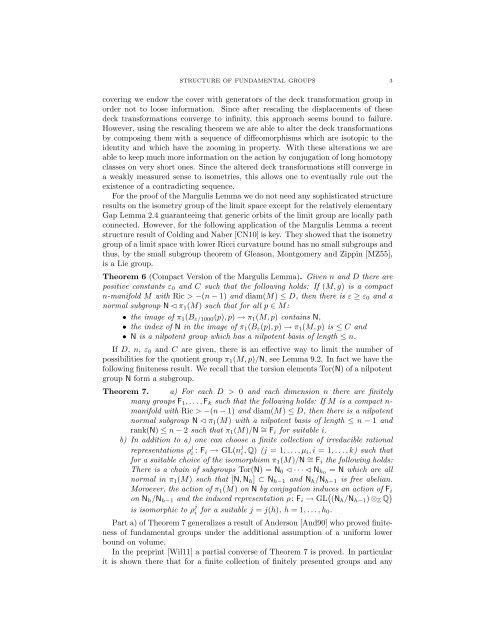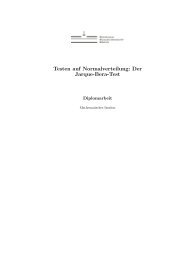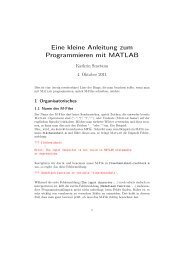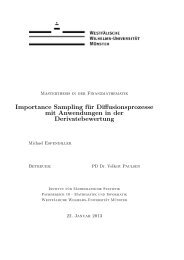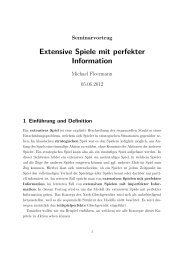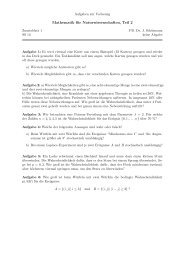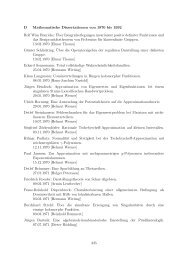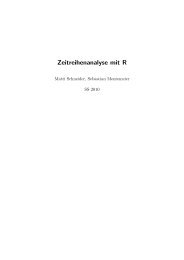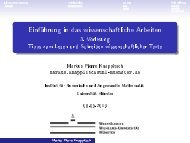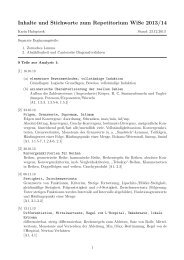Margulis Lemma
Margulis Lemma
Margulis Lemma
Create successful ePaper yourself
Turn your PDF publications into a flip-book with our unique Google optimized e-Paper software.
STRUCTURE OF FUNDAMENTAL GROUPS 3<br />
covering we endow the cover with generators of the deck transformation group in<br />
order not to loose information. Since after rescaling the displacements of these<br />
deck transformations converge to infinity, this approach seems bound to failure.<br />
However, using the rescaling theorem we are able to alter the deck transformations<br />
by composing them with a sequence of diffeomorphisms which are isotopic to the<br />
identity and which have the zooming in property. With these alterations we are<br />
able to keep much more information on the action by conjugation of long homotopy<br />
classes on very short ones. Since the altered deck transformations still converge in<br />
a weakly measured sense to isometries, this allows one to eventually rule out the<br />
existence of a contradicting sequence.<br />
For the proof of the <strong>Margulis</strong> <strong>Lemma</strong> we do not need any sophisticated structure<br />
results on the isometry group of the limit space except for the relatively elementary<br />
Gap <strong>Lemma</strong> 2.4 guaranteeing that generic orbits of the limit group are locally path<br />
connected. However, for the following application of the <strong>Margulis</strong> <strong>Lemma</strong> a recent<br />
structure result of Colding and Naber [CN10] is key. They showed that the isometry<br />
group of a limit space with lower Ricci curvature bound has no small subgroups and<br />
thus, by the small subgroup theorem of Gleason, Montgomery and Zippin [MZ55],<br />
is a Lie group.<br />
Theorem 6 (Compact Version of the <strong>Margulis</strong> <strong>Lemma</strong>). Given n and D there are<br />
positive constants ε 0 and C such that the following holds: If (M, g) is a compact<br />
n-manifold M with Ric > −(n − 1) and diam(M) ≤ D, then there is ε ≥ ε 0 and a<br />
normal subgroup N ⊳ π 1 (M) such that for all p ∈ M:<br />
• the image of π 1 (B ε/1000 (p), p) → π 1 (M, p) contains N,<br />
• the index of N in the image of π 1 (B ε (p), p) → π 1 (M, p) is ≤ C and<br />
• N is a nilpotent group which has a nilpotent basis of length ≤ n.<br />
If D, n, ε 0 and C are given, there is an effective way to limit the number of<br />
possibilities for the quotient group π 1 (M, p)/N, see <strong>Lemma</strong> 9.2. In fact we have the<br />
following finiteness result. We recall that the torsion elements Tor(N) of a nilpotent<br />
group N form a subgroup.<br />
Theorem 7. a) For each D > 0 and each dimension n there are finitely<br />
many groups F 1 , . . . , F k such that the following holds: If M is a compact n-<br />
manifold with Ric > −(n − 1) and diam(M) ≤ D, then there is a nilpotent<br />
normal subgroup N ⊳ π 1 (M) with a nilpotent basis of length ≤ n − 1 and<br />
rank(N) ≤ n − 2 such that π 1 (M)/N ∼ = F i for suitable i.<br />
b) In addition to a) one can choose a finite collection of irreducible rational<br />
representations ρ j i : F i → GL(n j i , Q) (j = 1, . . . , µ i, i = 1, . . . , k) such that<br />
for a suitable choice of the isomorphism π 1 (M)/N ∼ = F i the following holds:<br />
There is a chain of subgroups Tor(N) = N 0 ⊳ · · · ⊳ N h0 = N which are all<br />
normal in π 1 (M) such that [N, N h ] ⊂ N h−1 and N h /N h−1 is free abelian.<br />
Moroever, the action of π 1 (M) on N by conjugation induces an action of F i<br />
on N h /N h−1 and the induced representation ρ: F i → GL ( (N h /N h−1 ) ⊗ Z Q )<br />
is isomorphic to ρ j i for a suitable j = j(h), h = 1, . . . , h 0.<br />
Part a) of Theorem 7 generalizes a result of Anderson [And90] who proved finiteness<br />
of fundamental groups under the additional assumption of a uniform lower<br />
bound on volume.<br />
In the preprint [Wil11] a partial converse of Theorem 7 is proved. In particular<br />
it is shown there that for a finite collection of finitely presented groups and any


